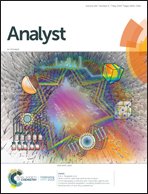A monoclonal antibody-based immunosensor for the electrochemical detection of imidacloprid pesticide†
Abstract
Imidacloprid (IMD) is one of the most used pesticides worldwide as a systemic insecticide as well as for pest control and seed treatment. The toxic and potential carcinogenic character of IMD makes its monitoring of great relevance in the field of agriculture and environment, so sensitive methodologies for in field analysis are strongly required. In this context, we have developed a competitive immunoassay for the determination of IMD using specific monoclonal antibodies followed by electrochemical detection on screen-printed carbon electrodes (SPCE). The optimized immunosensor exhibited a good reproducibility (RSD of 9%) and a logarithmic response in the range 50–10 000 pM of IMD, with an estimated detection limit (LOD) of 24 pM, which was below the maximum levels allowed by the legislation. High-Performance Liquid Chromatography-Mass Spectrometry-Mass Spectrometry (HPLC-MSMS) and Enzyme-Linked Immunosorbent Assay (ELISA) analysis were also performed for comparison purposes, where the electrochemical immunosensor exhibited a wider range of response and a lower detection limit. Matrix effects below 6.5% were obtained using tap water samples. All these characteristics make our electrochemical immunosensor a valid and advantageous tool for the in field determination of IMD.



 Please wait while we load your content...
Please wait while we load your content...